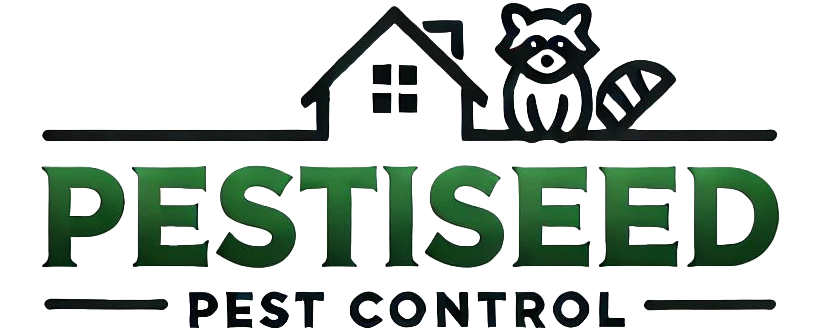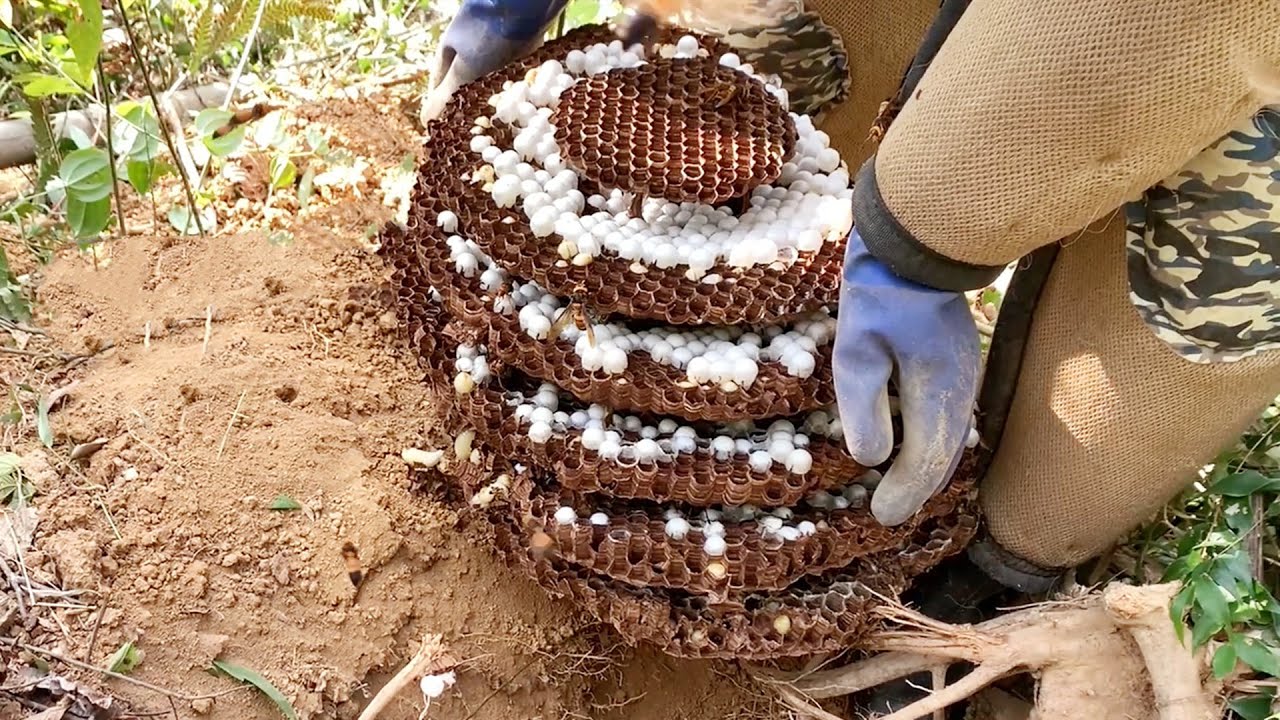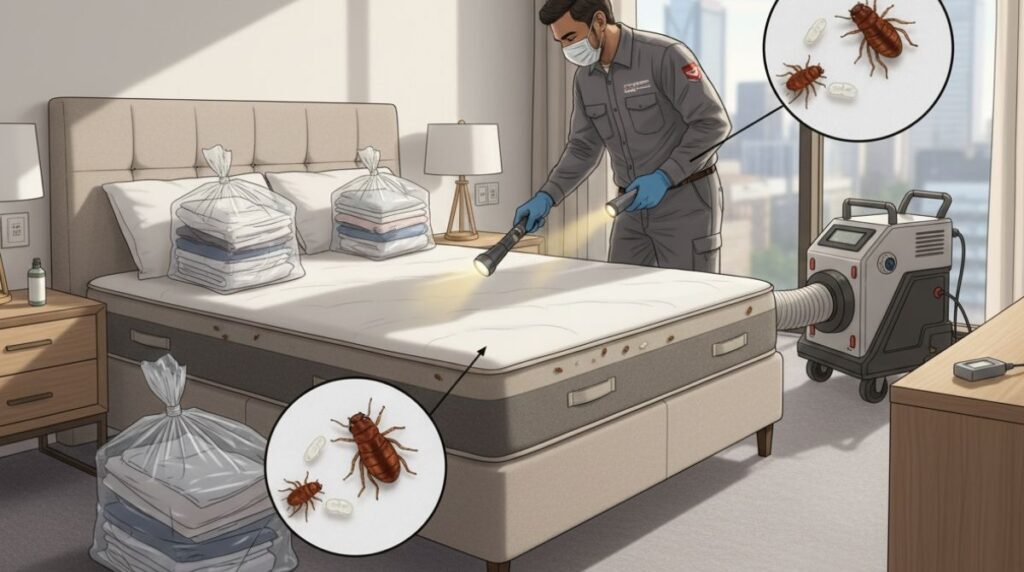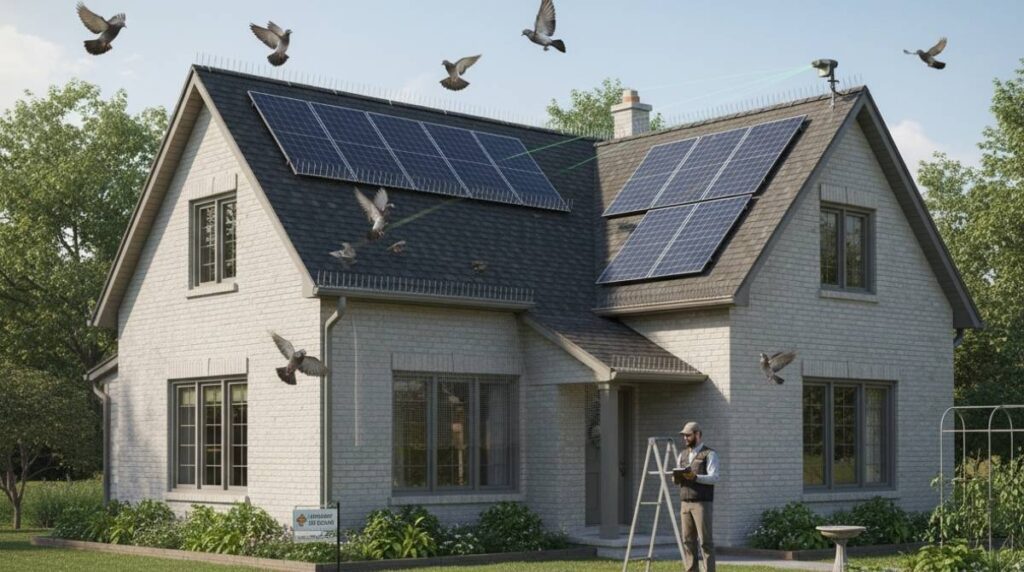Wasp nests identification saves lives in Toronto homes every summer. We see wasp infestations turn dangerous when homeowners guess wrong. A paper wasp acts calm until you threaten it. Yellow jackets swarm and chase you across your yard. Safety risks multiply when you mistake one species for another.
Species behavior differences mean everything in pest control work. Paper wasps hang their umbrella nests under your deck. They mind their own business most days. Yellow jackets hide underground or in your walls. They attack in groups without warning. Our licensed experts know these patterns after 5+ years experience. We offer fast service because timing matters with aggressive wasps. Legal considerations in Toronto require proper removal methods too. City bylaws protect certain beneficial insects while allowing wasp control. Our local trusted team follows all municipal rules. Same day availability means you don’t wait when danger lurks. 24/7 service covers emergencies that can’t wait until morning. Safe solutions protect your family and pets during treatment. Price starts on $99 with affordable rates no hidden fees. Guaranteed enjoy 10% off all pest control services trusted when you book today.
Species Behavior Makes All The Difference
Toronto weather creates perfect wasp conditions from May through September. Different species choose different spots around your home. Paper wasps prefer open areas where they see threats coming. Hornets build high in trees where they feel secure. Yellow jackets love tight spaces like wall voids and ground holes. Each species defends their territory in unique ways. Paper wasps give warning flights before they sting. Yellow jackets attack first and ask questions later. Knowing which wasp you face determines your next move. Wrong identification leads to wrong treatment approaches. This creates more danger for your family members.
Common Types of Wasp Nests in Toronto Homes
Toronto homes face three main wasp nest types that cause headaches. We see these paper wasp nest and yellowjacket nests problems daily. Our licensed experts know exactly what to look for. Each nest looks different and acts differently too.
Paper wasp nest hang like umbrellas under your porch roof. Yellowjacket nests hide in walls or underground holes. Hornet nests look like giant footballs in trees. We help Toronto families identify these dangers quickly. Our fast service keeps your family safe all summer long.
Paper Wasp Nests and Identification
Paper wasp nest look like upside down umbrellas made of gray paper. You can see all the hexagon shaped cells clearly. They hang from railings, door frames, and shed ceilings mostly. Paper wasps are less aggressive than other wasp nest types.
We spot these nests early in spring when they’re small. Our 5+ years experience shows these grow slowly through summer. Paper wasp nest rarely get bigger than a softball. They prefer protected spots away from wind and rain. Same day availability means we remove them before they grow. Safe solutions protect your family from painful stings. Price starts on $99 for small paper wasp removals.
Yellowjacket Ground and Wall Nests
Yellowjacket nests are the sneaky troublemakers we find everywhere. They build round paper balls completely enclosed with tiny entrance holes. Ground yellowjacket nests hide in old mouse holes or mulch beds. Wall yellowjacket nests squeeze into spaces behind your siding.
You only see wasps flying in and out constantly. The actual nest stays completely hidden from view. We use 24/7 service because yellowjackets become super aggressive quickly. These wasp nest types can hold thousands of angry wasps. Local trusted professionals never recommend DIY removal for yellowjackets. Guaranteed enjoy 10% off all pest control services trusted when you book yellowjacket removal. Affordable rates no hidden fees cover complete nest elimination.
Bald Faced Hornet Aerial Nests
Bald faced hornet nests are the giants of wasp nest types. They build massive gray football shaped fortresses in trees. These nests can grow over two feet tall by summer end. Only one entrance hole sits at the bottom usually.
We consider these the most dangerous wasp nest types in Toronto. Hornets attack in coordinated groups when threatened at all. Licensed experts wear full protective suits for these removals. Never attempt DIY removal on hornet nests ever. Our safe solutions include specialized equipment and protective gear. Fast service prevents these nests from reaching dangerous sizes.
How to Find Hidden Wasp Nests Around Your Home
Finding hidden nests takes patience and smart detective work. Wasp activity gives you the best clues about nest locations. We watch for busy flight paths during warm Toronto afternoons. Our licensed experts have tracked thousands of wasp nests over 5+ years experience. Local trusted professionals know where wasps love to hide.
How to find wasp nest locations starts with following the traffic. Wasps fly in straight lines to their homes. We offer same day availability when you spot suspicious activity. Our safe solutions protect your family during the search process. Fast service means we locate nests before they grow dangerous. 24/7 service helps when you discover wasp activity at any hour.
Visual Inspection Techniques
Start your search early morning when wasps move slowly. Check under deck railings and porch overhangs first. Look for small holes in siding or foundation cracks. Hidden nests often show tiny entrance points you might miss. We examine gutters, roof edges, and window frames carefully. Wasp activity increases near these protected spots during summer months.
Watch for chewed wood fibers around potential nesting sites. Paper wasps leave small wood shavings when building homes. Ground wasp nests create small dirt piles near entrance holes. Our affordable rates no hidden fees policy covers complete property inspections. Price starts on $99 for thorough nest location services. Guaranteed enjoy 10% off all pest control services trusted when you book today.
Following Wasp Flight Patterns
Track individual wasps as they return from hunting trips. They carry food directly back to their colonies. Stand 15 feet away and watch their flight direction. Multiple wasps using the same path signals nearby hidden nests. We trace these highways to find exact nest locations. Morning hours work best because wasps fly slower.
Mark the general area where flight paths end or begin. Wasp activity peaks between 10 AM and 4 PM daily. Use binoculars to follow wasps without getting too close. Never follow wasps at night when they become aggressive. Our team uses professional tracking methods for dangerous species. How to find wasp nest locations safely requires proper equipment and training.
Signs of Active vs Empty Wasp Nests
Telling if you have an active wasp nest or empty wasp nest saves you from danger. Traffic patterns show the biggest clue about wasp activity around your Toronto home. Active wasp nests have busy wasps flying in and out all day. You’ll see constant movement from dawn until dusk. Empty wasp nests show zero flying activity for several days straight. We tell Toronto homeowners to watch from a safe distance first. Our licensed experts with 5+ years experience know these traffic patterns by heart.
Nest condition changes dramatically between active and abandoned sites. Fresh active wasp nests look clean and well maintained by busy workers. The entrance holes stay clear and smooth from constant use. Empty wasp nests develop spider webs, debris, and weather damage quickly. Seasonal considerations matter greatly in Toronto’s climate too. Most nests become empty wasp nests after the first hard frost. We offer same day availability and 24/7 service because timing matters with wasp activity. Our fast service starts at price starts on $99 with affordable rates no hidden fees. Trust our local trusted team for safe solutions when identifying nest activity. Guaranteed enjoy 10% off all pest control services trusted when you call today.
Wasp Nest Locations by Property Type
Toronto homes attract wasps in different spots depending on your property type. Ground wasp nests hide in flower beds, under decks, and near garbage areas. Wasp nests in walls squeeze into tiny cracks around windows and doors. We see these wasp nest location patterns every day in our 5+ years experience. Our licensed experts know exactly where to look on each property type.
Fast service means we check all the sneaky spots wasps love. Detached homes have more hiding places than condos or townhouses. Same day availability helps Toronto families before nests grow bigger. We offer safe solutions that protect your family and pets. Local trusted professionals understand how Toronto’s weather affects where wasps build. Our 24/7 service covers emergencies when you find dangerous nests.
Detached Home Common Locations
Single family homes give wasps tons of hiding spots. Ground wasp nests love your garden shed area and compost bins. We find them under porch steps and deck railings too. Wall cavities near your electrical meter are wasp favorites. Attic vents and roof soffits attract flying wasps seeking shelter.
Price starts on $99 covers our thorough property inspection service. Garage door frames and window shutters need checking every spring. Basement window wells collect moisture that wasps need for building. Affordable rates no hidden fees means you know the cost upfront. Fence post holes and bird house areas are common nest spots.
Condo and Townhouse Nest Sites
Smaller properties still attract wasps but in different ways. Balcony planters and patio furniture create perfect wasp nest location options. Wasp nests in walls happen around shared utility areas and meters. Stairwell corners and mailbox clusters draw wasp attention quickly.
Guaranteed enjoy 10% off all pest control services trusted applies to all property types. Townhouse garages connect to neighbors which spreads wasp problems. Shared fence lines and garden borders need regular checking. Condo buildings have HVAC vents that wasps explore constantly. Parking garage corners and storage locker areas surprise many residents.
Toronto Seasonal Wasp Activity Guide
Wasp season Toronto starts in April when queens wake up from winter preparation. The cold months keep wasps sleeping in hidden spots. When wasps active depends on temperature and sunlight hours. We see the first scouts checking out last year’s nest development sites. May brings the real action as queens pick perfect spots. They love warm attics, shed corners, and deck railings.
Monthly activity levels jump fast once June arrives with hot weather. July and August become peak danger periods for Toronto families. Worker wasps get cranky hunting for sugary foods and protein. Our licensed experts handle dozens of calls daily during these months. Same day availability keeps families safe when nests grow basketball sized. Fast service matters because wasps multiply every single week. 5+ years experience taught us that 24/7 service prevents emergency stings. Safe solutions protect your kids while eliminating the threat. Local trusted professionals know Toronto’s wasp patterns better than anyone. Price starts on $99 with affordable rates no hidden fees. Guaranteed enjoy 10% off all pest control services trusted when you book before August.
Safety Protocols for Wasp Nest Inspection
Protective clothing saves lives when dealing with angry wasps. We always wear long sleeves and pants during inspections. Thick gloves protect your hands from painful stings. A hat with a face shield keeps wasps away from your eyes. Safe distances mean staying at least 10 feet from any nest. Our licensed experts use special gear during every inspection visit. Wasp nest safety starts with the right equipment and smart planning.
Emergency procedures can prevent serious medical problems during wasp encounters. We teach Toronto homeowners to move slowly away from nests. Never swat at wasps or make sudden movements near them. Wasp sting prevention works best when you plan your escape route first. Call our 24/7 service if you spot multiple wasps swarming together. Our fast service team arrives within hours for dangerous situations. Protective measures include keeping allergy medication nearby during summer months. We offer same day availability because wasp emergencies don’t wait. With 5+ years experience handling Toronto wasp problems, we know exactly how to keep families safe. Pestiseed Pest control price starts at $99 with affordable rates no hidden fees for peace of mind.
DIY vs Professional Wasp Removal Decision Matrix
Choosing between DIY wasp control and professional wasp exterminator services comes down to three key factors. Risk assessment factors show that small paper wasp nests might be manageable yourself. However, yellowjacket and hornet nests require licensed experts with proper protective gear. Cost considerations seem cheaper for DIY at first glance. Store bought sprays cost $15-30 but often fail. Our Pestiseed wasp removal Toronto service price starts on $99 with guaranteed results. Success rates tell the real story here. DIY attempts succeed only 20-30% of the time for ground nests. Professional wasp exterminator services achieve 95%+ success rates on first visit.
Safe solutions matter most when wasps get aggressive during removal attempts. We’ve seen Toronto homeowners end up in emergency rooms after DIY disasters. Our local trusted team brings 5+ years experience and fast service to every job. Same day availability means no waiting while dangerous nests grow larger. 24/7 service covers weekend emergencies when wasps attack family BBQs. Affordable rates no hidden fees policy ensures transparent pricing upfront. Guaranteed enjoy 10% off all pest control services trusted makes professional removal surprisingly budget friendly. Large nests cost thousands in medical bills if removal goes wrong.
Frequently Asked Questions
Toronto homeowners ask us these questions every day about wasp nests. Our licensed experts have seen every type of wasp problem in the city. We get calls about paper wasp nests under porches. We also remove dangerous yellowjacket nests from walls. Our 5+ years experience helps us answer these common concerns. Fast service means we solve your wasp problem quickly.
How do you know if a wasp nest is empty?
Look for wasp activity around the nest entrance. Active nests have wasps flying in and out all day. Empty nests show no movement at all. Check for fresh wasp droppings near the nest. Old nests look weathered and damaged. The nest material starts falling apart. We see this pattern every winter in Toronto. Our 24/7 service helps you check safely anytime.
What does a wasp nest look like in early stages?
Early paper wasp nests look like upside down umbrellas. They start smaller than a golf ball size. Yellowjacket nests begin as tiny holes in walls. Ground wasp nests show small entrance holes in soil. Fresh nests have bright gray paper material. The nest grows bigger each week through summer. Same day availability means we catch nests early.
How can you tell the difference between wasp and bee nests?
Wasp nests use gray papery material from wood. Bee nests use yellow wax for building. Wasps make open honeycomb structures you can see. Bees build closed wax combs inside hollow spaces. Wasp colonies are more aggressive than bee colonies. Paper wasps hang nests from roof edges. Bees prefer tree cavities and wall spaces.
Are wasp nests dangerous to remove yourself?
Paper wasp nests might be safe for small removals. Yellowjacket and hornet nests need professional help always. Aggressive wasps attack in swarms when threatened. Wasp stings can cause serious allergic reactions. Wrong removal methods make wasps more angry. Our safe solutions protect you from wasp attacks. Licensed professionals have proper protective gear.
What time of day are wasps least active?
Early morning hours before 8 AM work best. Wasps move slower in cool temperatures. Evening after sunset reduces wasp activity too. Hot midday hours make wasps most aggressive. Adult wasps return to nests at night. Cold weather slows down wasp movement patterns. We schedule pest control visits during safer times.
How big can wasp nests get in Toronto?
Paper wasp nests stay about softball size maximum. Yellowjacket nests can grow to basketball size. Hornet nests reach up to two feet tall. Large nests hold thousands of wasps inside. Summer heat helps nests grow faster. Toronto climate supports wasp growth from May to October. Price starts on $99 for small nest removal.
Do wasp nests come back in the same spot?
Old nests never get reused by new wasps. Wasp queens search for fresh nesting spots. Good locations attract different wasp species each year. Removing old nests prevents confusion about active infestations. Wasp free properties need regular pest monitoring. Affordable rates no hidden fees cover follow up pest control visits.
What attracts wasps to build nests near homes?
Sheltered sites like porch ceilings attract wasps. Food sources bring wasps to your yard area. Plastic containers and garbage cans provide building materials. Water sources help wasp colonies survive hot summers. Tree branches offer perfect aerial nest support. Guaranteed enjoy 10% off all pest control services when you identify problems early.




